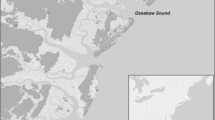Abstract
Numerous small (50- to 300-m-diameter) strong-backscatter objects were imaged on the 1200- to 1350-m deep crest of Vestnesa Ridge (Fram Strait) and along the 900- to 1000-m deep northeast margin of the Storegga slide valley. Ground-truthing identified most of these objects as 2- to 10-m-deep pockmarks, developed within soft, acoustically stratified silty clays (typical wet bulk density: 1400–1600 kg m-3; sound speed: 1480– 1505 m s-1; porosity, 65–75%; shear strength: 5–10 kPa; water content: 80–120%; and thermal conductivity: 0.8–0.9 W m-1 deg C-1 in the top 3 m). Gas wipeouts, enhanced reflectors, and reflector discontinuities indicate recent or ongoing activity, but the absence of local heat flow anomalies suggests that any upward fluid flows are modest and/or local.
Similar content being viewed by others
Author information
Authors and Affiliations
Rights and permissions
About this article
Cite this article
Vogt, P., Gardner, J., Crane, K. et al. Ground-truthing 11- to 12-kHz side-scan sonar imagery in the Norwegia–Greenland Sea: Part I: Pockmarks on the Vestnesa Ridge and Storegga slide margin. Geo-Marine Letters 19, 97–110 (1999). https://doi.org/10.1007/s003670050098
Issue Date:
DOI: https://doi.org/10.1007/s003670050098




